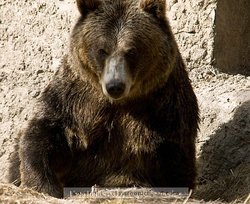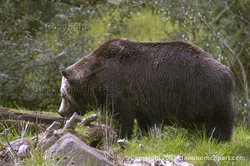Brown Bear
|
|
| Brown Bear Conservation status: Lower risk | ||||||||||||||
|---|---|---|---|---|---|---|---|---|---|---|---|---|---|---|
 Brown bear rearing | ||||||||||||||
| Scientific classification | ||||||||||||||
| ||||||||||||||
| Binomial name | ||||||||||||||
| Ursus arctos Linnaeus, 1758 |
The Brown Bear (Ursus arctos) is a species of bear that can reach weights of 130–700 kg (300–1500 pounds). The grizzly bear, the Kodiak bear and the Mexican brown bear are North American subspecies of the brown bear. It is sometimes referred to poetically as the bruin.
| Contents |
Appearance
Brown bears have coats in shades of blond, brown, black, or a combination of those colours; the long outer guard hairs are often tipped with white or silver, giving a "grizzled" appearance. Brown bears have a large hump of muscle over their shoulders which gives strength to the forelimbs for digging. Their heads are large and round with a concave facial profile. In spite of their size, they can run at speeds of up to 64 km/h (40 mph).
Habitat
Once native to Asia, Africa, Europe and North America, [1] (http://news.bbc.co.uk/2/hi/science/nature/4003325.stm) brown bears are now extinct in some areas and have had their numbers greatly reduced in others. They prefer semi-open country, usually in mountainous areas. The brown bear ranges from Alaska east through the Yukon and Northwest Territories, south through British Columbia and through the western half of Alberta. Isolated populations exist in northwestern Washington, northern Idaho, western Montana, and northwestern Wyoming. The subspecies U. arctos horribilis (the Grizzly Bear) is the common brown bear of continental North America; the subspecies U. arctos middendorffi (Kodiak bear) includes bears on the Alaskan islands of Kodiak, Afognak, and Shuyak. The range of the subspecies U. arctos nelsoni is in northern Mexico. In Asia, the Himalayan Brown Bear (U. arctos isabellinus) is found in the foothills of the Himalaya.
There are estimated to be about 200,000 brown bears in the world. The largest populations are in Russia, with 120,000, United States, with 32,500, and Canada with 21,750. Ninety-five percent of the population in the United States is in Alaska. In Europe, there are 14,000 brown bears in ten separate populations, from Spain to Russia.
Behaviour
The brown bear is primarily nocturnal and in the summer puts on up to 180 kg (400 pounds) of fat, on which it relies to make it through winter, when it becomes very lethargic. Although they are not true hibernators and can be woken easily, they like to den up in a protected spot such as a cave, crevice or hollow log during the winter months.
Being omnivores, they feed on a variety of plant parts, including berries, roots, and sprouts; fungi; and fish, insects and small mammals. Contrary to popular mythology, brown bears are not particularly carnivorous; they derive up to three-fourths of their dietary food energy from vegetable matter. Interestingly, bears eat an enormous number of moths during the summer—sometimes as many as 20,000 to 40,000 in a day—and may derive up to one third of their food energy from moths.
Brown bears have also been found stealing the kills of tigers, wolves, and pumas. Two male tigers were found killed by brown bears in the year 2000.
Normally a solitary animal, the brown bear congregates alongside streams and rivers during the salmon spawn. Every other year females produce one to four young which weigh only one pound at birth.
Habituation to human areas
With the encroachment of humans into bear habitat, bears may become attracted to human-related food sources such as garbage dumps, litter bins, dumpsters, etc., and may even venture into human dwellings or barns in search of food. Once a bear comes to associate human activity with a 'food reward', a bear is likely to continue to become emboldened in its quest for food and human/bear encounters become more likely. There is a saying: "a fed bear is a dead bear" which has come into use to popularize the idea that allowing bears to scavenge human garbage, pet food, or other food sources which draw the bear into contact with humans can result in disaster -- for the bear.Though bears have been relocated to areas distant from human populations, some bears become 'hooked' on a given food source and will return to the same location. Bears that have repeatedly returned to a given area, and thus have become perceived as dangerous are sometimes killed to prevent human injuries or death.
Yellowstone National Park, an enormous reserve located in the Western United States contains prime habitat for the Grizzly Bear (ursus arctos horribilis), as well as other Brown Bears, but due to the enormous number of visitors, human-bear encounters are not rare. The scenic beauty of the area has caused an influx of people moving into the area. In addition, because there are so many bear relocations to the same remote areas of Yellowstone, and because male bears tend to dominate the central core of the relocation zone, female bears tend to be 'pushed' to the boundaries of the region and beyond. The result is that a large proportion of 'repeat offender bears' -- bears that are destroyed for the public safety -- are females. This creates a further depressive effect on an already endangered species. Though the problem is most significant with regard to Grizzlies, these issues affect the other types of Brown Bear as well.
Subspecies
The subspecies of brown bears have been listed as follows; however, there is little agreement on classification:
- Ursus arctos arctos — brown bear
- Ursus arctos californicus — golden bear (extinct)
- Ursus arctos horribilis — grizzly bear
- Ursus arctos isabellinus — Himalayan Brown Bear
- Ursus arctos middendorffi — Kodiak bear
- Ursus arctos nelsoni — Mexican grizzly bear, (extinct?)
- Ursus arctos pruinosus — Tibetan bear
- Ursus arctos yesoensis — Hokkaido bear
Legal status
The grizzly bear (sometimes called the silvertip bear) is listed as threatened in the continguous United States.
- The golden bear disappeared from the state of California in 1922 when the last one was shot in Tulare County, California. It can be seen on the state flag of California and as the mascot of the sports teams of the University of California, Berkeley.
- The Mexican grizzly bear is listed as endangered and may be extinct.
- The grizzly bear is state listed as threatened in the lower 48 states in the United States. In Canada, it is listed as vulnerable in Alberta, British Columbia, Northwest Territories, and Yukon Territory. Prairie populations of grizzly bear are listed as extirpated in Alberta, Manitoba, and Saskatchewan.
Bear encounters
It is extremely rare that brown bears kill or seriously injure humans but fatal encounters do happen. There are an average of two fatal attacks a year in North America.1 In Scandinavia there are only three known cases during the last 100 years where humans have been killed by bears. This has usually happened because the bear is injured or a human encounters a mother bear with cubs. Some types of bears such as polar bears, are more likely to attack humans when searching for food while black bears are much less likely to attack.
The Scandinavian Bear Research project lists the following situations as potentially dangerous:
- Meeting an injured bear
- A human suddenly appearing between a mother and her cubs
- Meeting a bear in its cave
- Meeting a bear who has been provoked by a dog
A careful person should always try to avoid these situations. Anybody who walks in a forest where there are bears could carry around a bell since bears usually avoid humans. If somebody still meets a bear it is important to remain calm and to slowly walk in the opposite direction. A running human may give the bear the impulse to attack. It is important not to make threatening moves, not to make eye contact nor to shout. If a bear attacks and it is not possible to get away, the person should lie down in a fetal position and put his/her hands around the head to protect from bites. Image:YS_71506_241.jpg
Clipart and Animal Pictures
- Clipart (https://classroomclipart.com/image/category/clipart.htm)
- Animal Clipart (https://classroomclipart.com/image/category/animal-clipart.htm)
- Animal Animated Clipart (https://classroomclipart.com/clipart/Animations/Animals.htm)
- Pictures of Animals (https://classroomclipart.com/image/category/animal-photos.htm)
- Amphibian Clip Art, Pictures and Photogaphs (https://classroomclipart.com/image/category/amphibian-clipart.htm)
- Farm Animal Clip Art, Pictures and Photographs (https://classroomclipart.com/image/category/farm-animal-clipart.htm)
- Mammal Clip Art, Pictures and Photographs (https://classroomclipart.com/image/category/mammal-clipart.htm)
- Marine Animal Clip Art, Pictures and Photographs (https://classroomclipart.com/image/category/marine-life-clipart.htm)
- Reptile Clip Art, Pictures and Photographs (https://classroomclipart.com/image/category/reptile-clipart.htm)
- Spider Clip Art, Pictures and Photographs (https://classroomclipart.com/image/category/spider-clipart.htm)
Bear Pictures and Clipart
- Pictures of Bears (http://classroomclipart.com/cgi-bin/kids/imageFolio.cgi?direct=Animals/Bears)
- Bear Clipart (http://classroomclipart.com/cgi-bin/kids/imageFolio.cgi?direct=Clipart/Animals/Bear_Clipart)
Footnotes
Note 1: Bear Attacks: Their Causes and Avoidance, Stephen Herrero, revised edition, 2002.



